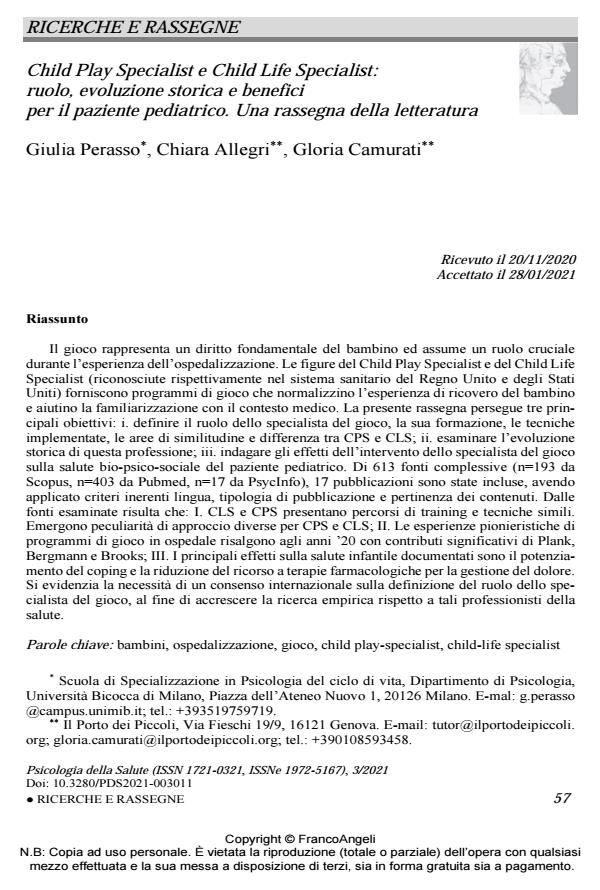Child Play Specialist and Child Life Specialist: role, evolution, and benefits for the pediatric patient. A litterature review
Journal title PSICOLOGIA DELLA SALUTE
Author/s Giulia Perasso, Chiara Allegri, Gloria Camurati
Publishing Year 2021 Issue 2021/3
Language Italian Pages 25 P. 57-81 File size 331 KB
DOI 10.3280/PDS2021-003011
DOI is like a bar code for intellectual property: to have more infomation
click here
Below, you can see the article first page
If you want to buy this article in PDF format, you can do it, following the instructions to buy download credits

FrancoAngeli is member of Publishers International Linking Association, Inc (PILA), a not-for-profit association which run the CrossRef service enabling links to and from online scholarly content.
Playing is a fundamental right of the child and it has a crucial role during the experience of hospitalization. The Child Play Specialist and Child Life Specialist (respectively certified in the UK and in the US healthcare system) provide play programs that normalize the child’s experi-ence in the hospital and help them in familiarizing with the medical context. This review has three main aims: i. defining the role of the play specialist, the training, the techniques imple-mented, the areas of similarity and difference between CPS and CLS; ii. examining the histori-cal evolution of this profession; iii. investigating the effects of the intervention of the play spe-cialist on the biopsychosocial health of the pediatric patient. 613 sourced were firstly consid-ered for a systematic selection (N=193 from Scopus, N=403 from Pubmed, N=17 from PsycInfo). 17 publications were finally included, after having applied language, type of publi-cation and relevance of content criteria. The sources examined show that: I. CLS and CPS pre-sent training paths and similar techniques. Different approach peculiarities emerge for CPS and CLS; II. Pioneering experiences of hospital gaming programs date back to the 1920s with significant contributions from Plank, Bergmann, and Brooks; III. The main documented ef-fects on child health are the enhancement of coping and the reduction of the use of drug thera-pies in pain management. This review highlights the need for an international consensus on the definition of the play specialist role, in order to increase empirical research around the play specialist intervention effects.
Keywords: children, hospital, playing, child play-specialist, child-life specialist
- Handbook of Research on Play Specialism Strategies to Prevent Pediatric Hospitalization Trauma Arianna Bentenuto, Silvia Perzolli, Simona de Falco, Paola Venuti, pp.240 (ISBN:9781668450680)
- Handbook of Research on Play Specialism Strategies to Prevent Pediatric Hospitalization Trauma Giulia Perasso, pp.306 (ISBN:9781668450680)
Giulia Perasso, Chiara Allegri, Gloria Camurati, Child Play Specialist e Child Life Specialist: ruolo, evoluzione storica e benefici per il paziente pediatrico. Una rassegna della letteratura in "PSICOLOGIA DELLA SALUTE" 3/2021, pp 57-81, DOI: 10.3280/PDS2021-003011